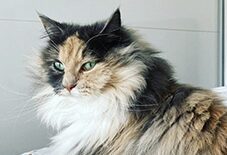
Meet the Selkirk Rex
Curly Cutie
Happiest in a Lap
Miss Congeniality
Looking for a cat disguised as a sheep? We Selkirk Rexes are the teddy bears of kitties, with curly coats, round heads, and big, adorable eyes that make you want to pick us up and give us a hug. And we don’t just look like teddy bears – we act like them, too! We can sit in our favorite human’s lap for hours on end.
If you need to go to work, we’re comfortable being left alone, but we're not exactly the most low-maintenance kitty around. We want lots of attention and need regular brushing for our thick, curly hair. Lots of brushing provides a great excuse to spend more time cuddling our curious, friendly selves. We’re happy cats with a lot of love to share with our human friends.
Ready to learn more about me? Let’s dig in.
Ready to learn more about me? Let’s dig in.
 My Many Looks
My Many Looks
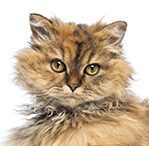
Brown

Grey
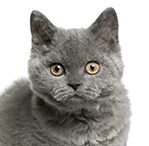
Blue
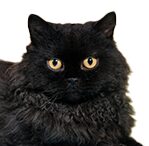
Black
 My Breed Characteristics
My Breed Characteristics
 Furbulous Fact
Furbulous Fact
Wondering why our hair looks a little messy? We promise we’re not having a bad hair day! Our unstructured curls and curly whiskers are as natural as they are adorable. Our curls are most prominent on our flanks, belly, and around our necks. If you’re wondering where they came from, our curls resulted from a happy cross-breeding accident between a Persian cat and a British Shorthair house cat.
 As I Grow Up
As I Grow Up
As you can see, we Selkirk Rexes age pretty gracefully. Here are a few key milestones in our growth and development to be aware of as we grow from a kitten, to an adult, to a senior!

Kitten < 2 years
After six months of curls, I’ll have a thin straight coat for a while. Introduce grooming to me early on, so that I like it later!
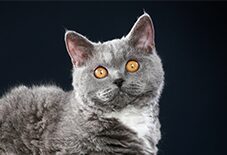
Adult2-9 years
Once I’m full-grown, my hair starts to resemble lamb’s wool. You’ll need to brush it two to three times a week to prevent tangles!
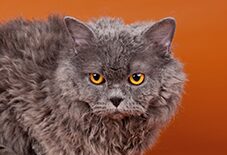
Senior9-15 years
As an older cat, I may slow down and become the ultimate lap cat. If I seem to be moving too slow, ask a vet about hip dysplasia.
 History of My Breed
History of My Breed
While many cats are bred intentionally for their looks, my curls appeared naturally. At an animal shelter in Montana in 1987, a feral blue Tortoiseshell cat and a white British Shorthair house cat met, and the house cat gave birth to one strange-looking kitten in a litter of five. The kitten had curly hair and whiskers, and it wasn't long before she caught the attention of a Persian breeder, Jeri Newman. Jeri named the curly kitten Miss DePesto, because she was always pestering Jeri for more love.
Jeri did some research and found out that Miss Depesto's mixed-breed mother also had hair that slightly varied in texture. But Miss Depesto's hair was remarkable in that her whiskers were curly, she had matted hair in her ears, and there were waves of hair all over her body. Miss Depesto also had prominent cheeks, and a wide flat spot between her ears. Similar to a Cornish Rex, her body was heavy, but her legs were long. Because all of Miss Depesto's siblings had normal coats, and because there were no other curly cats in the area, Jeri decided that Miss Depesto might be carrying a new gene. Jeri bred Miss Depesto with a black Persian male cat, and of the six kittens born, three had curly hair. It was a dominant gene! The Selkirk Rex gene, that is. Not long after that, in 1999, the International Cat Association accepted us into their New Breed Program. We were the talk of the town at the championship competition, and we've been winning humans' hearts ever since.
 Pawesome Cats to Parent
Pawesome Cats to Parent
In addition to purebred Selkirk Rex cats like me, there are tons of purrfectly sweet mixed-breed Selkirk Rex cats that are looking to find their furever homes. Learn where to find yours below!
 Care Tips
from Dr. Sara Redding Ochoa, DVM
Care Tips
from Dr. Sara Redding Ochoa, DVM 
Make sure you screen for genetic issues.
Selkirk Rex is a generally healthy breed, but they can be prone to a few genetic issues. Hip dysplasia and cardiac issues are relatively common, so cats should be genetically tested before breeding.
Brush their fur often.
Selkirk Rex have very curly hair, which means that their fur can become easily matted. Gently brushing them and removing mats and tangles will help keep their fur healthy - and give you built-in quality time with your kitty.
Make sure to cat-proof your home.
Selkirk Rexes tend to be very curious cats. They will open drawers and cabinets in your house and get into things that they shouldn't. Make sure that you keep any harmful chemicals, plants, and human medication in a safe area that your cat cannot access.

 Why Get Cat Insurance?
from Pumpkin®
Why Get Cat Insurance?
from Pumpkin®
While the Selkirk Rex is a generally healthy breed, cat-astrophes can happen to any cat at any age. If your kitty gets hurt or sick, pet insurance can help you say ‘yes’ to the best care, even when it’s costly. When it comes to shopping for this breed, you’ll want to choose insurance plans like Pumpkin's, which can help cover the costs associated with the hereditary conditions the Selkirk Rex is prone to developing. While a reputable breeder will conduct genetic testing on your kitty’s parents to help minimize the chances of passing down hereditary conditions, they can’t always be avoided. Let’s look at some common ones, and how Pumpkin Cat Insurance plans could help cover the cost of care!
 Hip Dysplasia
Hip Dysplasia
Hip dysplasia results in the malformation of the ball and socket of hip and elbow joints. It's caused by a combination of genetics and playful habits, which makes it a common condition for the Selkirk Rex cat. Dysplasia can cause pain, decreased mobility, and weight gain for your Selkirk Rex.
- Cost to Treat
- $2,500 (surgical)
- Pumpkin Plans Pay Back*
- $2,250 (surgical)
 Polycystic Kidney Disease
Polycystic Kidney Disease
Polycystic Kidney Disease (PKD) is a genetic kidney disease that can occur in Selkirk Rexes, characterized by the growth of cysts on the kidneys. As it progresses, the kidneys are more prone to infection and failure. Drainage of cysts, low protein diets, and Vitamin D supplements are used to slow the disease’s progression.
- Cost to Treat
- $3,000-$6,000
- Pumpkin Plans Pay Back*
- $2,700-$5,400
 Urinary Tract Infections and Bladder Stones
Urinary Tract Infections and Bladder Stones
The Selkirk Rex is prone to developing urinary tract conditions like infections, and bladder stones, in which minerals build up and can make urination extremely painful or impossible, depending on severity. While small bladder stones can be removed via a catheter, larger stones require surgery.
- Cost to Treat
- $500-$3,500 (surgical)
- Pumpkin Plans Pay Back*
- $450-$3,150
 Heart Disease
Heart Disease
Selkirk Rex cats may develop heart problems, specifically Hypertrophic Cardiomyopathy (HCM). In this condition, the walls of the heart muscle thicken, which causes a slow decline in cardiac function. While there is no cure, heart disease can be managed with medication and a well-balanced diet.
- Cost to Treat
- $500-$3,000 (surgical)
- Pumpkin Plans Pay Back*
- $450-$2,700
*Example illustrates reimbursement of a covered vet bill at a 90% reimbursement rate, where the annual deductible had already been satisfied and the annual limit had not yet been met. Coverage and reimbursement results vary based on policy options.


